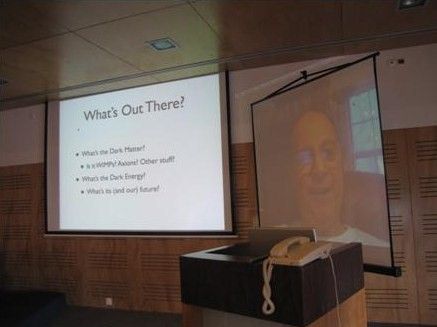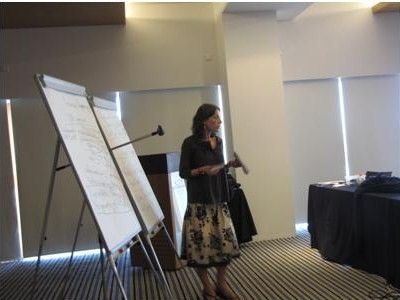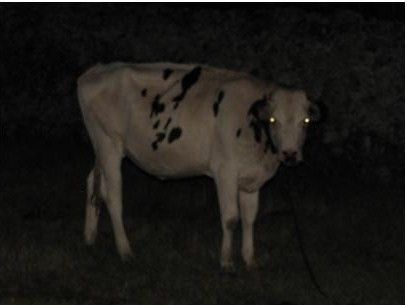Now that the Azores conference is officially over, I will try and quickly catch you up on (some of) the more serious sessions and the 46 odd talks that were given. I also recommend visiting Backreaction for Sabine Hossenfelder's take on the meeting in general and the future of sex in particular (the latter being a topic brought up when delegates pondered scenarios for the next 100 and 1000 years, as I posted earlier.)
Wednesday kicked off with a talk by Paul Davies with the tongue-twisting title, "Teleology without teleology," about the search for a law of increasing complexity in the universe.

Alan Guth and Frank Wilczek (or a virtual version of Frank Wilczek via video link, photo courtesy of Max Tegmark) both updated talks I have blogged about previously, so I'll just direct you to those posts for a detailed description of Guth's thoughts on finding a measure in the multiverse, and Wilczek's thoughts on the foundational questions that still remain to be answered.
Both Guth and Wilczek's talks fed into later debates. Guth had made an interesting point in motivating his belief in the existence of a multiverse, asking how many nouns in the dictionary lend themselves to the thought that there is only one of them? "Two: 'God' and 'universe'," he said. "Scientifically it makes more sense to lump 'universe' in with planets, galaxies...and assume there is more than one of them, than lump them in with God."
However, in the discussion afterwards there was a passionate split over whether it makes any sense to talk about the multiverse when there was no (current) way of testing whether such a thing exists. Meanwhile, some of the ideas brought up in Wilzcek's talk were revisited when delegates were asked to come up with scenarios for the future of the universe/multiverse.
Friday had a mixed bag of 27 talks (stunningly the schedule only overran by 15 minutes) covering time, cosmology and quantum gravity.
John Wheeler once wrote: "No question about quantum gravity is more difficult than the question, 'What is the question?" and that was apparent during the day. Claus Kiefer advocated "quantum geometrodynamics" as a way to tackle the problem. Rodolfo Gambini is investigating how you can even define a clock in the realms where quantum gravity rages--a question that Andy Albrecht also works on.

Ettore Minguzzi reprised his discussion of why we can't take global time for granted from the FQXi Nature of Time contest. Laura Mersini-Houghton (photo courtesy of Max Tegmark) stated that the arrow of time can be explained in the multiverse view: assuming that there is time symmetry in the multiverse, the act of a new universe budding off from the background breaks this symmetry and creates an arrow within the baby universe. How compelling people found that depended a lot on whether they are fans of the multiverse picture or not.
Fred Adams took a path into some of those alternative universes with different physical laws and made us all feel a little bit less special by showing that stars can still develop in universes with parameters that differ from ours. This suggests that the parameters in our universe may not need to be as finely-tuned as we thought for life to occur, with possible repercussions for the anthropic principle.
Anthony Aguirre wins the prize for the best Douglas Adams shout-out, by discussing the arrow of time with the aid of slides (to come) of a piano decomposing into a gas, which by freak chance reassembles itself into a bowl of petunias ("but not a whole whale as that would be too complex.") Unfortunately, I was so pleased about the reference to Hitchhiker's, I forgot to note what the graphic was meant to demonstrate, so I'll let Anthony come in and explain that his himself, when he has time.
Olaf Dreyer set up an interesting philosophical fight between two views of special relativity: Einstein's (in which matter conforms to the background) and Lorentz or Bell's view (in which matter defines geometry). He then pondered if by extending the Lorentz view into general relativity it would be possible to find a way that geometry could emerge from a phase transition (something that isn't possible when looking at Einstein's GR).
Steve Savitt found himself as the only philosopher in a room full of physicists. He argued that simultaneity is still consistent with a notion in which the past, present and future are ontologically different. The problem, he said, was in the use of inappropriate language to describe time as "flowing" or "moving" (which he says it doesn't do) rather than "passing" or "lapsing" (which it does do).
Back on the cosmology track again, Glenn Starkman weighed up modified gravity theories against dark matter and dark energy.
Garrett Lisi attempted to unify the standard model and gravity in one slide. Xiao-Gang Wen described his string-net liquid model with the same goal in mind.
Sabine Hossenfelder promised to talk about something truly "repulsive" and she did: antigravitation. But she didn't levitate any frogs. Instead, she talked about a second copy of the standard model, identical to the one we know, except with a negative gravitational interaction.
Finally, lone experimentalist Dmitri Budker talked about tests of whether the constants of nature are really as constant as advertised.
The final session on Sunday covered quantum mechanics. Bob Coecke, Dan Browne (not the one responsible for this, thank goodness), Howard Barnum and Caslav Brukner tried to recast quantum mechanics in terms of information theory (discussed in detail in Bob Swarup's article, "The End of the Quantum Road?"
Coecke did so in terms of "quantum spiders." I googled "quantum spider" and came across the line: "Just ran into one of those quantum spiders in my apartment-- one of the ones that emerges spontaneously from the vacuum. And if I had a vacuum (cleaner, that is) it'd be vanishing back into it . . ." That's not quite what Coecke had in mind, nor was he talking about Spiderman's nemesis. Rather he was introducing a new graphical technique to describe the interaction between classical and quantum data in quantum informatic protocols to aid in quantum computation. You can see if they really do look like spiders in his paper here.
While Browne investigated whether Bell's inequalities can be written in terms of information theory, Joy Christian made the controversial statement that Bell had based his theorem on mistaken assumptions and that quantum entanglement is an illusion. If correct, Christian could take the spookiness out of quantum mechanics; but most in the audience stood by Bell.
But speaking of spookiness, the most important thing I learned from the Azores trip? In a land where there is one cow for every human resident, you really don't want to mess with the cows. (Photo courtesy of Max Tegmark.)

You can find out more about the conference here.